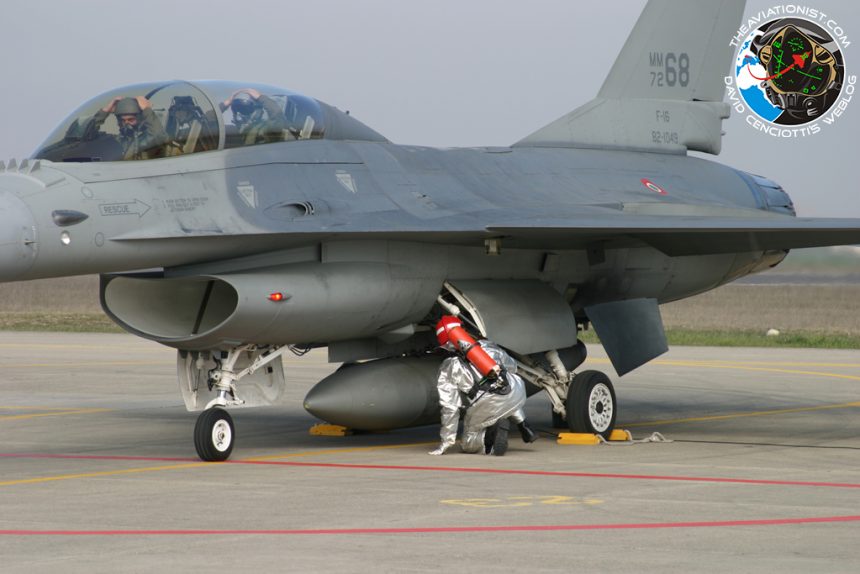Italian version available here
Hydrazine is a colorless liquid (for more info click here) that feeds the electrical systems and the EPU (Emergency Power Unit) in case of engine failure.
Should a flame-out occur, hydraulic and electrical systems are fed by the electrical current generated by the EPU, activated by the engine or by a system propelled by hydrazine. Hydrazine is highly toxic and highly inflammable, and can be dangerous for the health of whom is accidentally exposed to it. Each squadron equipped with F-16s must be able to manage engine emergencies requiring the EPU using methodologies that do not leave space to improvisation.
Even the 5th Stormo based in Cervia, Italy, has defined a procedure that foresees the management of the eventual loss of liquid, the escape of the crew from the aircraft and the subsequent decontamination. Let’s see how this procedure works.
Let’s imagine the following scenario: an aircraft has just declared an emergency after experiencing an engine flame-out, failure that provokes the activation of the hydrazine-propelled EPU. As soon as the aicraft lands, it is taxied towards one of the selected decontamination zones, located next to the northern threshold of the 12/30 runway in Cervia. In order to prevent the dispersion of eventual vapors of hydrazine, the pilot moves the aircraft against the wind and waits for the arrival of the first firefighting team. This first team is composed by an On-Scene Commander (OSC) and two firefighters.
The OSC moves in front of the aircraft, in a position from which he can direct and manage the operations of the entire team, and communicate with the pilot using a language made only of gestures.
After receiving the go-ahead signal from the OSC, the firefighter operator positioned on his right side, following a path purposely traced to prevent whichever risk posed by the aircraft intake, approaches the left wing of the F-16 and, passing under the fuel tank, inserts the spins to the undercarriage and gun.
After completing the operation, the OSC signals the pilot to turn the engine off, operation that allow the fireman to approach the cockpit and release the ladder used by the crew to abandon the aircraft. Before leaving the F-16, the crew has to wear the mask to prevent toxic vapor inhalation.
As soon as the crew is distant and safe, the fireman on the left of the OSC, wearing a particular protecting cover (Level B), approaches the aircraft next to the hydrazine tank (located at the connection between the fuselage and the leading edge of the right wing). This operator has to check eventual leaks that can be revealed by stains on the ground caused from liquid spillage.
As soon as the first assessment has been completed, the first team is replaced by a “response team hydrazine” composed by 2 Italian and 1 American operator, equipped with special overalls (Level A, since risk of contact with the liquid is higher), that clear the leak along the track followed by the aircraft from the runway to the parking area.








